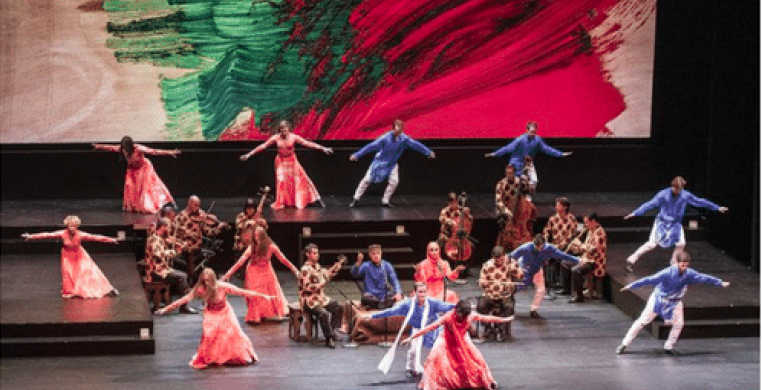Love’s extremes drive Mark Morris’s sumptuous visualization of the ancient Persian story, “Layla and Majnun,” a tale of star-crossed lovers in love with the agony and ecstasy of love (Harris Theater, March 16-17).
Interesting and informative as the extensive program notes are, you don’t have to read them to appreciate the beauty and poetic resonance of this ambitious collaboration between The Mark Morris Dance Group and Yo-Yo Ma’s Silk Road Ensemble. It is, however, worth recognizing the overarching emblem of cross-cultural pollination that characterizes the Silk Road Ensemble, named after the ancient trade route that connected the East and West, dating back to 207 BCE.
The Silk Road Ensemble’s 2007 chamber music reworking of Azerbaijani composer Uzeyir Hajibeyli’s 1908 opera incorporates text from Nezami Ganjawi’s 12th-century Persian romance, “Laili and Majnun.” The universal story of ill-fated lovers, reminiscent of “Romeo and Juliet,” embodies culturally specific religious allusions to the yearning for spiritual purification and divine love in the afterlife.
Seated on a draped platform center stage, premiere Azerbaijani virtuoso singers, Alim Qasimov and his daughter, Fargana Qasimova, chant the two main characters’ dialogue in the genre of mugham, the traditional, improvised modal music of the former Soviet republic. A blend of traditional Azerbaijani folk and conventional Western orchestral instruments surrounds and accompanies them in a horseshoe configuration framed by scenic and costume designer Howard Hodgkin’s simple, multi-level set. The bold red, green, and orange brushstrokes of Hodgkins’ giant abstract mural covering the entire back wall loom over the proceedings, contrasting the windswept motion of modern Western art with the ancient ceremonial sounds, ritualized presentation, and traditional attire of the performers.
The dance, which enters the configuration after a prologue medley of traditional Azerbaijani songs, takes place above and around the musical center, and is both peripheral and central to the whole in a weaving of movement and sound that builds an integration of meaning between the mournful voices, instrumental orchestration, and physicalization of the text. Traditional Azerbaijani melodies and rhythms create an almost tangible geography of the cultural crossroads of Eastern Europe and Western Asia, where Azerbaijan is located. The Azerbaijani text (projected above in English translation) connects the singers’ voices and emphatic gestures to the choreography, which expands in space with phrases of longer duration and repetition, intensifying the mounting drama of longing and separation. "The true purpose of love is sacrificing oneself," the text proclaims, justifying the lovers' tragic ending.
The dancers, men in long blue tunics and white pants, women in flowing, ankle-length peach-toned dresses, mirror the sweeping arcs of color in Hodgkins’ backdrop with the “S”-shape of arm movement that swoops and dives sideways into wide second-position lunges across space. The highly-stated postures and poses of the 12-member ensemble recall Grecian friezes, Etruscan pottery, or the illustrations of the great Chinese, Japanese, and Indian master painters.
The storytelling is loosely represented in five acts, with different couples taking the roles of Layla and Majnun in each segment, the whole ensemble echoing and amplifying, Greek chorus style, throughout. Mirroring Silk Road Ensemble’s instrumental mix of East and West, traditional and modern sounds, Morris’ movement invention combines the skittering bourrées of young love fluttering, Middle-Eastern folk dance forms, and balletic cabrioles, with primitive ceremonial gesture and pageantry. The overall impact is mesmerizing, with an energy and momentum that transports us to a non-linear state of mind that allows for each of us to become Layla and Majnun, aching so desperately for each other and for the idealization of love.
“Layla and Majnun” is not story ballet as we know it, or concert dance we have come to expect from Mark Morris for that matter, but rather, a journey into the “unexpectable,” a synthesis of cultures through live music, visual art, and dance that is uniquely its own, and a very special spectacle to behold.

